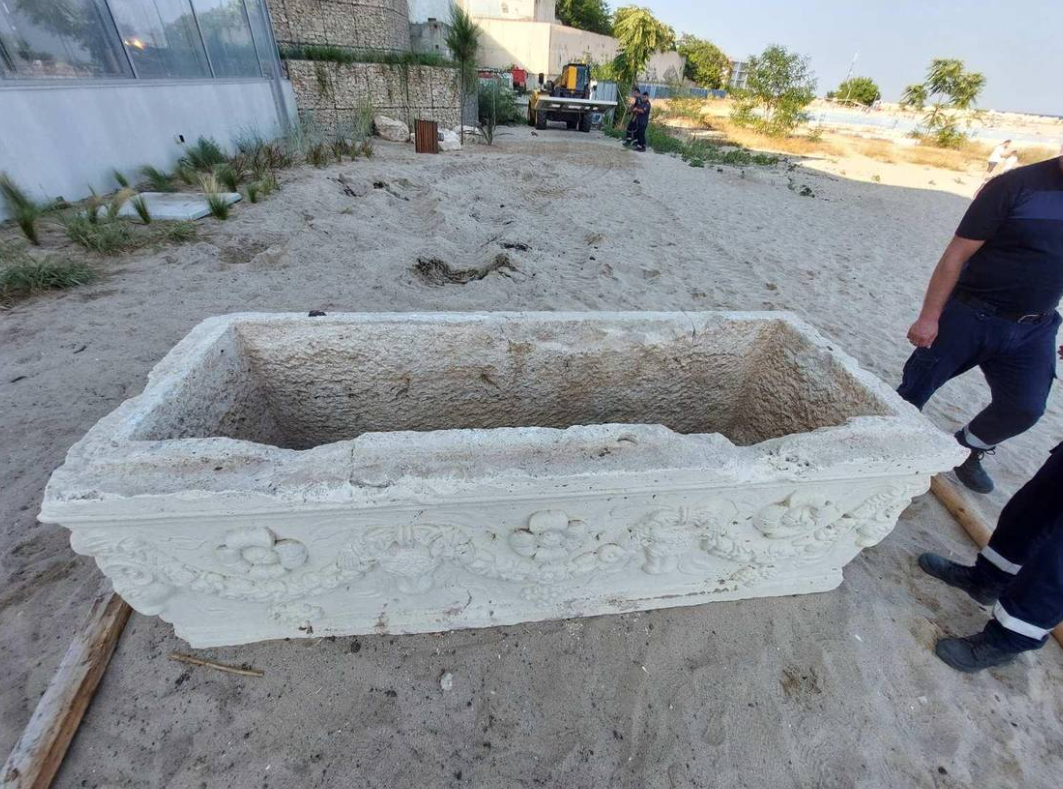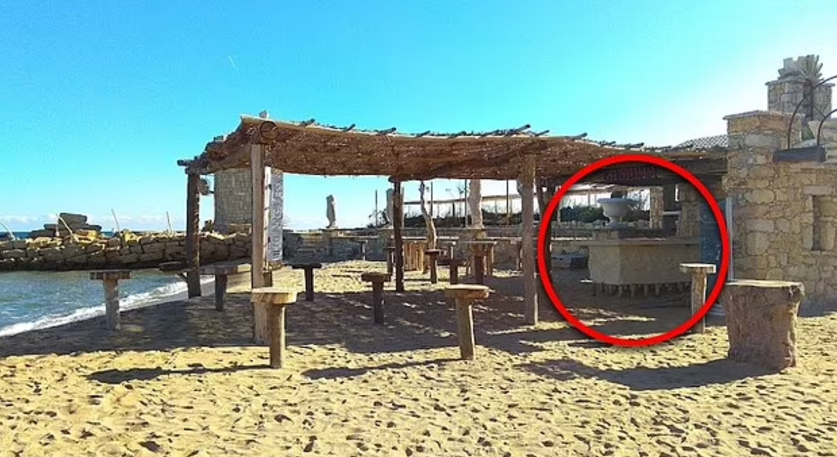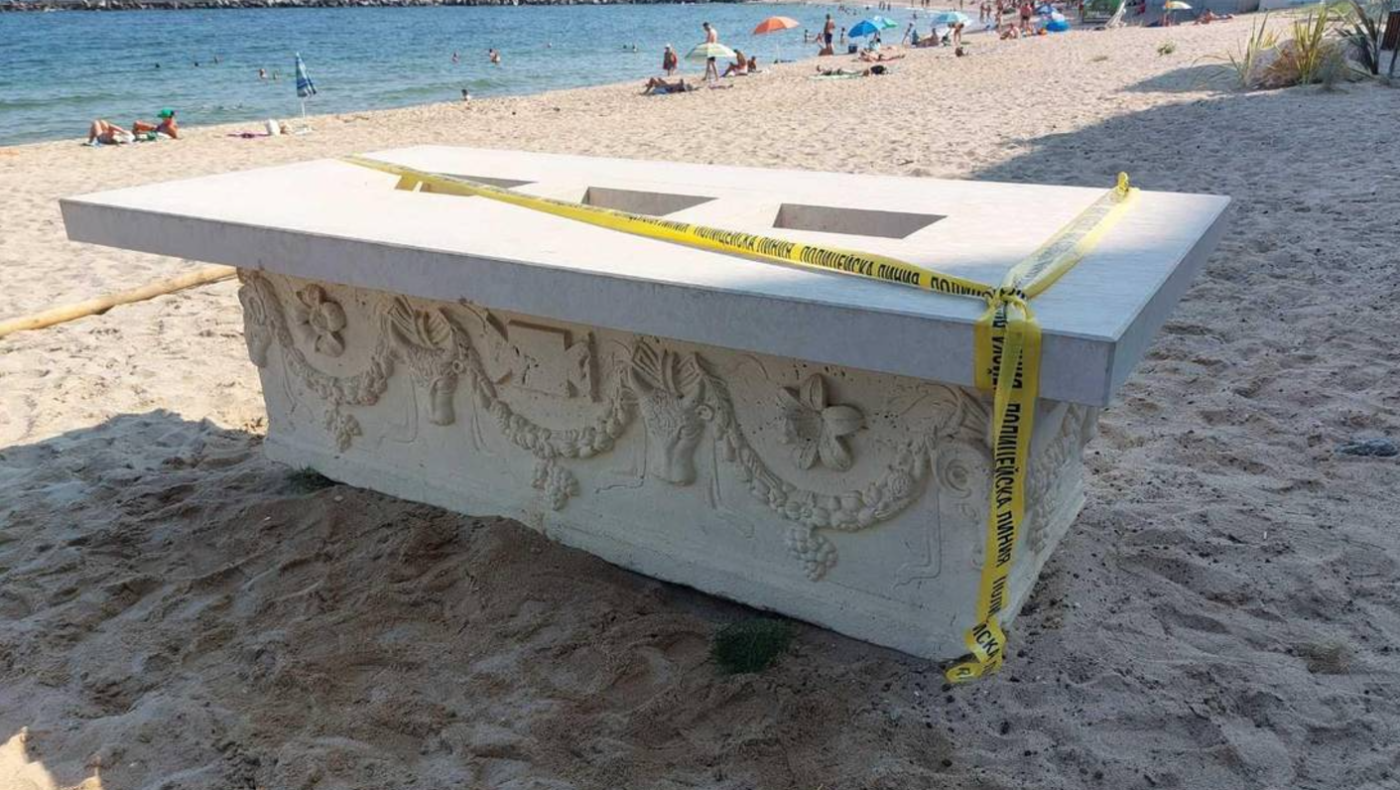In an unexpected twist of history meeting modern-day leisure, a tourist in Varna, Bulgaria, stumbled upon a remarkable artifact: a 1,700-year-old Roman sarcophagus repurposed as a table at a local beach bar. This discovery has sparked widespread intrigue, shedding light on the region’s rich history and the sometimes surprising ways ancient relics resurface in everyday life. Join archeology.dulichvn.net to decode this curiosity through the following article.
A Beach Bar with a Roman Sarcophagus
The Tourist’s Surprising Find
Varna, a vibrant coastal city on the Black Sea in Bulgaria, is famous for its sandy beaches, cultural heritage, and ancient history. Amid the lively atmosphere of beachside bars and modern establishments, a tourist made an astonishing discovery that seemed almost surreal. While enjoying the relaxed ambiance of a beach bar, this observant visitor noticed something unusual—a table with elaborate carvings that stood out from the rest of the decor.

Upon closer examination, the “table” was revealed to be a 1,700-year-old Roman sarcophagus, an ancient stone coffin likely crafted around the 3rd century CE. The artifact’s intricate designs and craftsmanship clearly pointed to its historical significance. Yet, here it was, being casually used as furniture in a bustling modern-day bar.
A misuse or a coincidence?
The presence of such a remarkable relic in an unexpected setting raises many questions. Was it an intentional repurposing of an ancient artifact, or had it found its way to the bar by coincidence? The sarcophagus, originally designed to honor and house the remains of the deceased, had been stripped of its solemnity and transformed into a surface for drinks and snacks.
For some, the situation was a source of humor and curiosity—a stark juxtaposition of history and modern leisure. Others, however, expressed discomfort and concern over the perceived disrespect for an object of profound cultural and historical importance. Regardless of perspective, the incident highlighted the gap between preserving heritage and the casual treatment of ancient relics in everyday life.
See more: The Skull of a Young Athlete: A Golden Relic of Ancient Greek Athleticism
Local Reactions
The discovery quickly became a topic of discussion among locals, historians, and visitors. The reactions ranged from fascination to indignation.
For locals and tourists: Many were amused by the irony of enjoying cocktails atop a piece of ancient history. The bar’s unique “table” inadvertently became a draw, sparking conversations about Varna’s rich Roman past.
For historians and archaeologists, the sight of a Roman sarcophagus in such a context was alarming. They emphasized the importance of respecting and preserving historical artifacts, noting the risks of neglect or misuse in eroding cultural heritage.
This discovery has brought to light a broader issue: how to balance modern development and tourism with the responsible stewardship of historical treasures.
The Historical Context of the Sarcophagus
What Is a Sarcophagus?
A sarcophagus is a stone coffin, often adorned with intricate carvings, inscriptions, or symbolic motifs. In Roman times, these artifacts were typically reserved for the elite and were designed to commemorate the deceased with dignity. Commonly crafted from durable materials like marble or limestone, sarcophagi have survived centuries, serving as windows into the art, culture, and beliefs of ancient civilizations.

Varna’s Roman Legacy
Varna, known as Odessus during the Roman Empire, was a flourishing city and a key port on the Black Sea. Its strategic location made it a hub for trade, culture, and military activity. The discovery of the sarcophagus is not surprising, as numerous Roman artifacts have been unearthed in the region, including baths, mosaics, and burial sites.
The presence of a sarcophagus in Varna reinforces the city’s historical importance, but its use as a table highlights the ongoing challenges of protecting and appreciating these relics.
The Broader Implications of the Discovery
A Wake-Up Call for Cultural Preservation
This incident serves as a stark reminder of the need for better awareness and policies regarding historical preservation. Artifacts like the sarcophagus are not just relics of the past; they are invaluable resources for understanding history, culture, and human development.
Allowing such artifacts to be misused risks diminishing their value and erasing the stories they tell. Instead, proper efforts should be made to recover, study, and display these treasures in appropriate settings, such as museums or cultural institutions.
The Role of Tourism in Heritage Conservation
Tourism can be both a blessing and a challenge for historically rich regions like Varna. While it generates economic benefits and brings attention to cultural sites, it can also lead to the neglect or exploitation of heritage if not managed responsibly.

In this case, the tourist’s keen eye brought attention to the sarcophagus, potentially sparking action to preserve it. This underscores the importance of fostering a sense of responsibility among visitors and locals alike in protecting shared cultural assets.
See more: The Mercury Train: A Streamlined Masterpiece of Midwest Rail Travel
What Happens Next?
Immediate Actions for the Sarcophagus
Historians and local authorities have expressed interest in recovering the sarcophagus and conducting a thorough examination of its origins and significance. Plans are being discussed to relocate the artifact to a museum or heritage center, where it can be properly studied and preserved.

The Bar Owner’s Perspective
The bar owner, likely unaware of the artifact’s significance, may face questions about how the sarcophagus came to be part of their establishment. Whether it was purchased unknowingly or inherited with the property, the incident highlights the need for education and awareness about handling historical items.
Long-Term Goals for Varna’s Heritage
Varna’s authorities and cultural institutions are now considering broader measures to prevent similar incidents in the future. These could include:
- Public awareness campaigns about the city’s archaeological legacy.
- Stronger regulations to protect artifacts and penalize their misuse.
- Collaborations with historians and archaeologists to identify and catalog historical items in public and private spaces.
The Historical Significance of Roman Sarcophagi
What Is a Sarcophagus?
A sarcophagus, derived from the Greek word sarkophagos meaning “flesh-eater,” was a stone coffin often used in ancient civilizations. These structures were typically adorned with detailed carvings, inscriptions, and symbolic motifs that reflected the status, beliefs, or achievements of the deceased.

In Roman times, sarcophagi were commonly used for burials, especially for wealthy or prominent individuals. They were crafted from durable materials like marble or limestone, ensuring their longevity through the centuries.
The Roman Influence in Varna
Varna holds a rich history as part of the Roman Empire. Known as Odessus during Roman rule, the city was a thriving hub of trade and culture. Numerous artifacts from this period, including baths, amphorae, and now a sarcophagus, have been unearthed, highlighting its significance in antiquity.
The presence of a Roman sarcophagus in Varna is no surprise given the city’s storied past. However, its unexpected setting at a modern bar underscores the need for greater efforts to protect and showcase such relics properly.
Preservation Challenges in Bulgaria
Bulgaria is home to countless archaeological treasures from its Thracian, Roman, and Byzantine pasts. However, limited funding and awareness sometimes lead to the mishandling or neglect of historical artifacts. This incident serves as a reminder of the importance of education and investment in cultural heritage.
See more: The Mummy of Pharaoh Amenhotep’s Beloved Dog: A 3,500-Year-Old Relic
The Broader Implications of the Discovery
Raising Awareness of Cultural Heritage
The sarcophagus-turned-table highlights the fine line between preserving history and repurposing artifacts for everyday use. While it is not uncommon for ancient relics to be reused throughout history, their cultural and educational value must be recognized and respected in modern times.
The Role of Tourism
Tourism can play a pivotal role in uncovering and preserving historical artifacts. The tourist’s keen observation brought attention to an overlooked relic, potentially sparking initiatives to study and protect it. This incident underscores how visitors to historical regions can inadvertently contribute to cultural preservation efforts.
A Call for Conservation
Historians and archaeologists have called for the sarcophagus to be removed from the bar and placed in a museum or appropriate cultural institution. Doing so would not only preserve the artifact but also educate the public about its historical significance.
Conclusion
The discovery of a 1,700-year-old Roman sarcophagus at a beach bar in Varna, Bulgaria, is as surprising as it is thought-provoking. While the artifact’s unconventional use sparked amusement and concern, it also served as a powerful reminder of the region’s rich history and the ongoing need for cultural preservation.
As Varna continues to balance its historical significance with modern tourism, this incident underscores the importance of respecting and protecting the past. With proper conservation efforts, the sarcophagus can become more than just an anecdote—it can be a celebrated piece of history that connects Bulgaria’s ancient legacy with its vibrant present.


CÁC TIN KHÁC
Mary Walton: The Forgotten Inventor Who Helped Clean Up America’s Cities
Tomb of Queen Nefertari in the Valley of the Queens, Egypt
Discover the Hypostyle Hall of the Temple of Hathor at Dendera
Venus de Losange: Unveiling the Mystery of a 20,000-Year-Old Paleolithic Icon